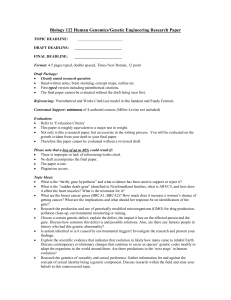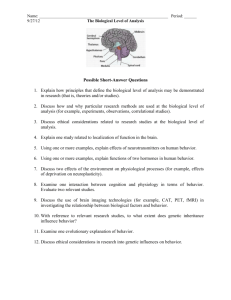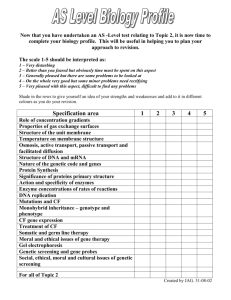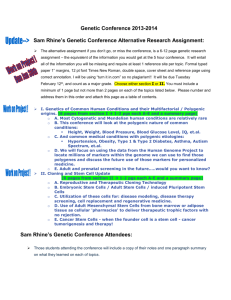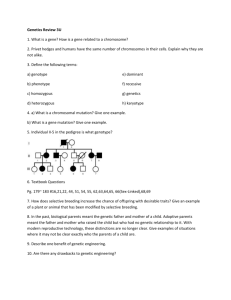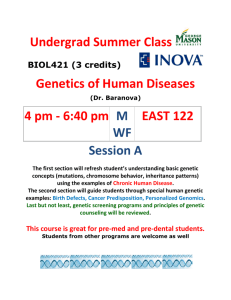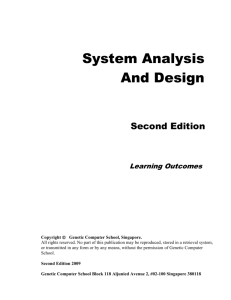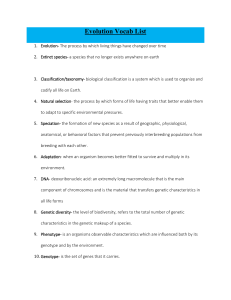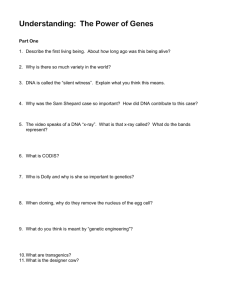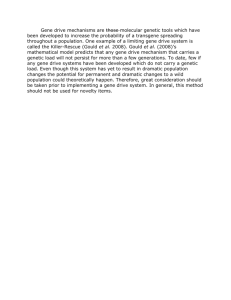ANW Chapter 5 What is ethics? Ethics is the branch of philosophy
advertisement
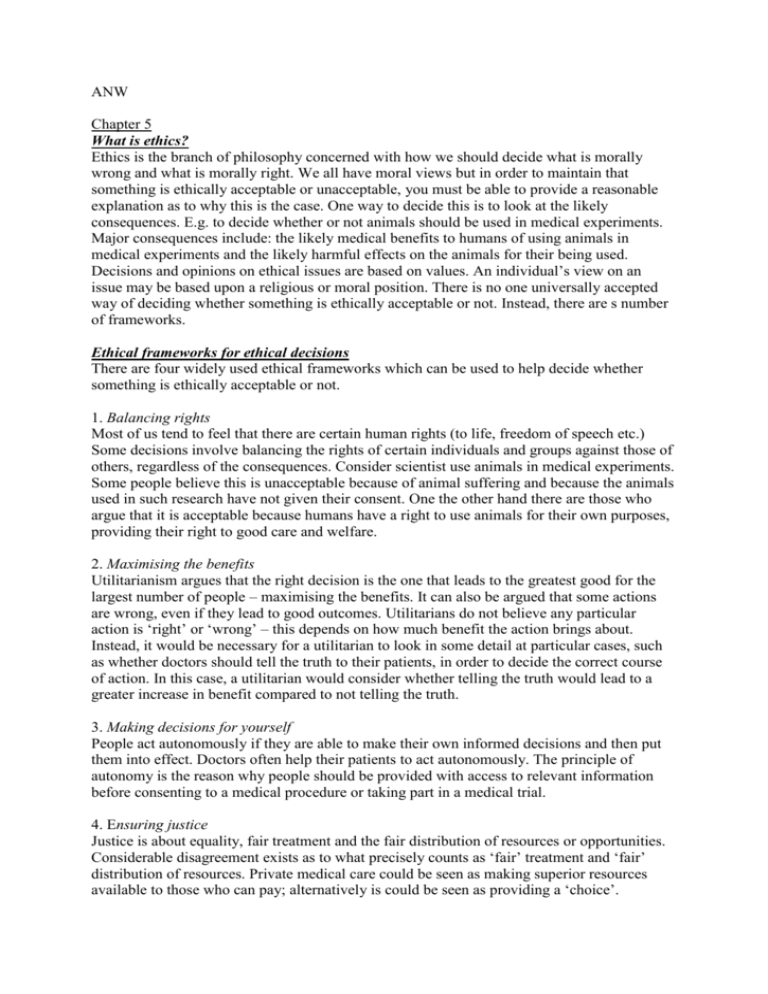
ANW Chapter 5 What is ethics? Ethics is the branch of philosophy concerned with how we should decide what is morally wrong and what is morally right. We all have moral views but in order to maintain that something is ethically acceptable or unacceptable, you must be able to provide a reasonable explanation as to why this is the case. One way to decide this is to look at the likely consequences. E.g. to decide whether or not animals should be used in medical experiments. Major consequences include: the likely medical benefits to humans of using animals in medical experiments and the likely harmful effects on the animals for their being used. Decisions and opinions on ethical issues are based on values. An individual’s view on an issue may be based upon a religious or moral position. There is no one universally accepted way of deciding whether something is ethically acceptable or not. Instead, there are s number of frameworks. Ethical frameworks for ethical decisions There are four widely used ethical frameworks which can be used to help decide whether something is ethically acceptable or not. 1. Balancing rights Most of us tend to feel that there are certain human rights (to life, freedom of speech etc.) Some decisions involve balancing the rights of certain individuals and groups against those of others, regardless of the consequences. Consider scientist use animals in medical experiments. Some people believe this is unacceptable because of animal suffering and because the animals used in such research have not given their consent. One the other hand there are those who argue that it is acceptable because humans have a right to use animals for their own purposes, providing their right to good care and welfare. 2. Maximising the benefits Utilitarianism argues that the right decision is the one that leads to the greatest good for the largest number of people – maximising the benefits. It can also be argued that some actions are wrong, even if they lead to good outcomes. Utilitarians do not believe any particular action is ‘right’ or ‘wrong’ – this depends on how much benefit the action brings about. Instead, it would be necessary for a utilitarian to look in some detail at particular cases, such as whether doctors should tell the truth to their patients, in order to decide the correct course of action. In this case, a utilitarian would consider whether telling the truth would lead to a greater increase in benefit compared to not telling the truth. 3. Making decisions for yourself People act autonomously if they are able to make their own informed decisions and then put them into effect. Doctors often help their patients to act autonomously. The principle of autonomy is the reason why people should be provided with access to relevant information before consenting to a medical procedure or taking part in a medical trial. 4. Ensuring justice Justice is about equality, fair treatment and the fair distribution of resources or opportunities. Considerable disagreement exists as to what precisely counts as ‘fair’ treatment and ‘fair’ distribution of resources. Private medical care could be seen as making superior resources available to those who can pay; alternatively is could be seen as providing a ‘choice’. The ethics of researching and testing medicines with animals and humans Most people agree that it is wrong to make animals suffer by using them in medical experiments. However most also agree that there are some circumstances when the interests of animals may be outweighed by the interests of human beings. People find this acceptable so long as everything possible is done to minimise the pain and distress of the animals. Others, however, think that all use of animals for medical research and testing is wrong, no matter how great the benefits. Animal rights Animal rights is an ethical framework which guides some people’s moral positions about humans’ use of animals. Giving laboratory animals rights at one level means that they are provided with water, food, exercise and veterinary treatment. Accepting that animals have rights on a level with human rights would make it difficult to justify using them in medical research for the benefit of humans. Animal welfare A greater believe that animal rights is the belief that humans should treat animals well so far as possible. In Europe there are strict guidelines to show which animals can be used for research, what they can be used for and the way they should be treated. Both the animal rights and animal welfare approach assume that animals can suffer pain and experience pleasure. A utilitarian who holds the belief that the right course of action is the one that maximises the amount of overall happiness or pleasure in the world would allow certain animals to be used in medical experiments, provided the overall expected benefits are greater than the overall expected harm. Obligations of pharmaceutical companies Pharmaceutical companies have responsibilities towards the fair pricing of medicines, the availability of medicines, research and development to produce new medicines, and medicine safety and quality. They also have a responsibility to act ethically in the treatment of animals and humans in research. Medical ethics committees The task of an ethics committee is to advise pharmaceutical companies on whether the potential benefit of a clinical trial is worth the risk to the volunteers. For this reason the committee should be independent of the company producing the medicine and the research team carrying out the trial. The committee should mirror the make-up of the local community in the committee there are doctors, two people from professions allied to medicine, lay people (lawyer, someone from a religious organisation). They advise on the recruitment of suitable volunteers for phase I trials so that they are not sought from grouts which seem too vulnerable. An important aspect of the work of the committees is to ensure that volunteers understand what is involved so that they can give informed consent. Patents One way that pharmaceutical companies balance their needs and obligations is through patenting medicines early in their development. Scientist publish their new methods, processes and products as patents. Some processes and products may be declared nonpatentable if their use would be ‘contrary to the public order or morality’ (for example for when there will ever be a cure for cancer if there is a patent on it, the maker would ask a lot of money and only the rich can afford it then so it will be declared non-patentable). Factors affecting the availability and use of medicines Patents are territorial rights. The European Patent Convention inventions patented in other European countries are protected. Similar patent rules are across almost the entire world. The process of research and development is long and slow, so it is very expensive to bring a new medicine on the market. Companies take out patents which apply in many countries makes sure that only that company who developed the medicine is allowed to sell it. Patents however can drive up the prises because research and development are costly and need to be covered. However, some experts argue that money is spent on marketing and not on researching new drugs; they develop drugs, very similar to those already on the market but patented by the rival company. Sales of medicines which treat very rare but life-treathening diseases are low so pharmaceuticals won’t invest in them that’s why the governments incentives (lower licensing fees, money towards the research and developing etc.) to encourage companies to develop these ‘orphan’drugs. Drugs for developing countries Developing countries cannot afford the cost of essential medicines. Especially not if companies protect their patents in order to maximise the profits so make their medicine more expensive). There is little financial incentive for research and development into treatments needed in the developing world, where the need is great but the profits are low. Individual countries can negotiate to but the medicines at lower cost. In some cases governments are able to override the patents to produce their own however, often the generic drug is then smuggled out of poor countries and sold in richer countries at discounted prices which may make pharmaceutical countries reluctant to offer discounted prices. Stem cells and cloning Stem cells can divide to produce copies of themselves or to form many other types of cells. They are found in the early embryo, the foetus, the placenta and umbilical cord and many tissues of the body. Embryonic stem cells Embryotic stem cells can be taken for research from spare human embryos left over from fertility treatments, or from cloned human embryos developed in the laboratory. One method for making cloned embryos is called nuclear transfer. The nucleus from a donor is inserted into an empty egg cell. After the resulting hybrid cell had been ‘activated’ (normally using an electrical pulse), it begins to divide, creating new cells. The embryotic cells produced can be used for therapeutic cloning. The cloned embryo could be used for reproductive cloning. This is illegal for human embryos. Tissue stem cells Stem cells can be derived from various tissues in the adult (e.g. bone marrow). These stem cells help to maintain, and in some cases repair, the tissue in which they are found. Adult stem cells are relatively unspecialised. They can usually only give rise to specific cell types. This means that tissue stem cells can only turn into a limited range of cell types. Stem cells: Are unspecialised does not have any specialized physiological properties or functions. Can divide and produce copies of themselves over and over again. Have the potential to produce other cell types in the body when it divides it can either produce identical daughter cells, or it can produce more specialised cell types. Provide an ideal model for studying the development of organisms help scientists understand how a complex organism develops from a fertilised egg. Identifying the factors that determine whether a stem cell chooses to carry on replicating or differentiates into a specialized cell type, will help scientists to understand what controls normal cell development. Generative medicine Scientists are studying what happens when they transplant stem cells into the damaged or diseased tissue of animals and humans. The hope is that the transplanted stem cells van regenerate missing cells (e.g. bone marrow transplant). It is hoped that researchers will find ways of treating other disease by directing stem cells in the laboratory to produce the specialized cell types needed for transplantation. A lot of research is therefore focused on identifying which factors consistently induce stem cells to become certain cell types. If scientists find ways to grow cells that are all the same, pharmaceutical companies could use them to test drugs reduces the testing on animals and the early stages of testing the effect of toxicity of medicines could be investigated in these cells. Stem cells and bone marrow Professor Stephen Proctor injected a leukaemia patient with blood stem cells from discarded placentas and umbilical cords the stem cells grew new bone marrow cancer went into remission. Following successful animal research, stem cell transplants are now routine in the treatment of several types of cancer enable patients to undergo high doses of chemotherapy despite the toxic effects of the drugs on bone marrow. Further development (still in practice) use donor stem cells to treat certain serious and often fatal inherited blood disorders patient’s own bone marrow, which produces diseased blood cells, is destroyed and replaced by donor stem cells. Peer review When findings are published by an individual scientist or research group, their data, and their interpretations of their data, are carefully checked by the scientific community ‘peer review’ helps to detect invalid claims in reports of scientific work and adds weight to valid ones. Scientist value observations and measurements that are replicable. Ethical concerns about the use of stem cells and cloning Stem cell research raises many ethical and societal issues relating to the source, uses and storage of stem cells. It also raises concerns about fair access (because of patents) and the risks to patients. Embryonic stem cells The ethical issues which arise from research with embryonic stem cells depend on the moral status of a human embryo. Some people believe that an embryo should have full human rights from its conception. Other people think that the embryo’s rights increase as it develops the potential benefits of the research should be weighed against the respect given to the embryo at each stage of its development. Utilitarians consider the seriousness of the disease and the potential number of people that research could help. Scientists take stem cells from early embryos which would otherwise be discarded from abortions, fertility treatments and embryos produced specially for the research. The ethical acceptability of using fetal tissue from abortions is closely tied to the views on abortion. An embryo produced by IVF has been created with a view to implantation in the uterus if not implanted they will be discarded removal and cultivation of cells from these unwanted embryos need not indicate lack of respect. Informed consent from donors is complex, as the future of the embryonic cells may be unclear fully informed consent would involve the researchers disclosing any potential commercial benefits and sources of funding of embryo research it is worth noting that obtaining informed consent from embryo donors assumes the parent ‘owns’ the embryo, and the embryo doesn’t have rights of its own. How does society decide what is right and what is wrong? Scientist have to ensure that their practice is ethical and they have to abide by national or international regulations, which may also have an ethical basis. EU member states have different positions regarding the regulations according to the different ethical, philosophical and religious beliefs. Decision makers are influenced by the mass media, special interest groups, public opinions and expert evidence. Stem cell research is coordinated by the UK Stem Bank Europe’s first centralized stem cell resource, providing scientists with shared access to research. Bank was set up with full support of UK government they were allowed under certain conditions: To promote advances in the treatment of infertility To increase knowledge about the causes of congenital disease To increase knowledge about the causes of miscarriage To develop more effective methods of contraception To develop methods for detecting gene or chromosome abnormalities in embryos before implantation The main aim of the government was to make the huge amount of research possible that is needed to understand stem cells. Is human cloning legal? HFEA gives licenses to allow scientist to work with stem cells. On 11th August 2004, the HFEA announced they had granted a license to researchers to perform therapeutic cloning for the first time. Human cloning is illegal in many countries because it has not been proven to be medically save, scientifically sound, or socially and ethically acceptable. Reproductive cloning as a technique is difficult and unpredictable. Many cloned animal offspring are born with severe abnormalities which raised the possibility that any surviving human clone could face serious health problems, and that the surrogate mother would also be at risk during the pregnancy. Also no human clone would ever be truly identical to its genetic parent they might look similar, but they would grow up in a different time and environment, with different social and cultural influences. In addition, the knowledge that you are genetically identical to your ‘parent’ could add an immense psychological pressure. On the other hand twins are ‘natural’ clones. Chapter 6 What are genetic diseases? Genetic diseases are diseases in the genes. Most of which run through the family and therefore can be inherited. Some genetic diseases are the result of problems with whole chromosomes most common of this type is Down’s syndrome they have an extra copy of one chromosome. This causes slow and limited mental development and many physical problems. Chromosome abnormalities are not usually passed from one generation to the next as the people affected are often sterile, and often do not live long enough to reproduce. Key terms: Every individual carries two copies of each gene, one inherited from the mother and one from the father. A gene is a length of DNA on a chromosome that carries the genetic instructions for a particular feature (eye colour etc.). In the nucleus of a cell, DNA is packaged into long, coiled strands called Chromosomes. The nuclei of human body cells contain 46 chromosomes. DNA is the chemical which carries a code making up the genetic information in a cell. DNA is a long-chain molecule made up of separate units joined together. At fertilization, the nuclei of an egg and a sperm cell fuse, producing, in humans, a cell with 23 pairs of chromosomes. Each chromosome pair contains one chromosome from the mother and one from the father. Gene expression is the process by which a gene’s coded information is translated into an inherited characteristic. Cystic fibrosis Some genetic diseases are the result of just one faulty gene. Cystic fibrosis causes severe problems in breathing and digestive systems linked to thick, sticky mucus which the body cannot shift. It shortens the life of sufferers, who may need physiotherapy several times a day, and take many drugs. The cystic fibroses gene occurs in many alternative forms or alleles. Alleles are different forms of a gene some are dominant and some recessive recessive only determine the characteristics by that gene if the dominant is not present. There is one allele which is the normal form this is the dominant allele. There is also a large number of mutated alleles which are faulty forms of the gene the mutated alleles are all recessive. As long as a person inherits at least one normal form, he or she will be healthy. A person has to inherit faulty alleles from both parents for the symptoms to show up so both parents need to be carriers of the disease if their child suffers from cystic fibrosis. Huntington’s disease Huntington’s disease is caused by a single dominant gene. Until very recently sufferers only knew they were affected when the symptoms began to show (age 30-50) which meant they already had children. It is very rare. Huntington’s disease involves the gradual destruction of nerve cells in the central nerve system. The person begins to have involuntary jerking or writhing movement of their arms and legs, and strange facial grimaces. Changes in personality occur, including laughing and crying at the wrong time, inappropriate anger, memory loss and bizarre behaviour. The pattern of symptoms varies a lot, but the patient usually loses the ability to communicate several years before their inevitable death. In 1983 Dr James Gusella discovered a DNA sequence associated with the Huntington’s gene which means people don’t have to wait in uncertainty before knowing if they have the disease they can plan their own future, and also plan whether to have children they can decide to not have children and remove the risk of passing on the gene or decide to have children but test the fetuses and end the pregnancy is the Huntington’s gene is present. Some people also don’t want to know if they have inherited the disease because they find it unbearable to learn that they have inherited a completely untreatable disease. Multifactorial inheritance Most inherited characteristics and medical conditions are influenced by multiple genes as well as multiple environmental factors. Many of the common diseases that affect the West are called multifactorial disorders because they have some inherited genetic component but are also influenced by the environment. These diseases, such as cancer and heart disease, present a real challenge for medical genetics due to their complex nature. Some of the genes that make individuals susceptible to cancer and heart disease have been identified, and the presence of mutations can now be tested for. Case-control studies Large-scale studies can help to identify genes that contribute to complex diseases since individuals with alleles that predispose them towards a disease are statistically more likely to be affected. Similarly, those with alleles that protect them from a disease are statistically less likely to be affected. Case-control studies select particular groups for study. Case-control studies are studies in which patients who already have a certain condition are compared with people who do not. If a disease is rare, case-control studies allow large numbers of sufferers to be studied (cheap, easy and quick). Participants are normally compared with a healthy control group to see if the differences account for why some people become ill and some others don’t. By collecting DNA with medical and lifestyle data from hundreds of thousands of people, and following their long-term health, researchers can work out why some people develop a particular disease while others do not. ‘Prospective’ biobanks carry out this type of study. Does cancer have a genetic cause? The rate of formation of new cells matches the requirements for growth and for replacing cells that have been lost (control program). When a person has cancer, the control program breaks down the cell becomes abnormal starts dividing uncontrolled. These abnormal cells do not work properly as part of the organ or tissue where they began and prevent them from working properly get in the way of the activity of normal cells and take up more and more room. Cancer cells can break away and travel through the bloodstream, to other parts of the body, where they may form new colonies of abnormal cells. All cancer is genetic because its triggered by altered genes but only a small portion (5-10%) is inherited. Most cancers come from random mutations that develop in the body cells as a mistake when cells are going through cell division or as response to injuries from environmental agents (e.g. certain chemicals). When damaged cells reproduce, the new cells inherit these mutations. The risk of cancer increases as we get older amount of mutations in our body cells increases with age. A minority of mutations are potentially serious as they can lead to the inheritance of a genetic disease. Environment and lifestyle also play an important role in the development of cancer. Main factors of developing cancer: diet, exercise, age, previous medical history, genetic factors. Heart disease and genes Research into heart disease The research from the Universities of Leicester and Leeds in July 2007, had begun to show how our genetic make-up can lead us to develop heart disease, and how we can predict who is most at risk. The study confirmed six new combinations of genes that increase the likelihood of developing coronary artery disease. First they analysed 2000 people with coronary artery disease and 3000 healthy people. The researchers found that changes in the DNA on chromosomes 1, 2, 10 and 15 were associated with an increased risk of developing coronary artery disease. The study also confirmed the importance of a gene on chromosome 9 associated with increased risk. The researchers are now working to understand exactly how this leads to heart disease. Coronary heart disease A person suffers a heart attack when the reduction in blood supply through the coronary artery interrupts the blood flow to the heart muscle. Obstruction is caused when the smooth lining of the blood vessels becomes toughened and thickened by fatty plaque deposits. The plague causes the blood vessel to rupture, and blood clots form, blocking the flow of blood. ‘Is the baby all right?’ With the technology nowadays we can find out an amazing amount about a baby before its born. Antenatal testing is used to pick up genetic problems in the developing fetus and to identify problems during development, where the fetus fails to form properly for a variety of reasons. Antenatal tests Screening tests relatively early in pregnancy pick up women who are at risk of having a baby with Down’s syndrome and other genetic diseases. The simplest methods involve blood tests and ultrasound scanning. Ultrasound scanning non-invasive the equipment does not penetrate the body shows if the fetus is developing normally. If there are any concerns amniocentesis or chorionic villus sampling is carried out to examine for abnormalities. Amniocentesis Involves removing some of the amniotic fluid which surrounds the fetus fetal cells can be recovered from the fluid, and, after the cells have been grown in a culture for a couple of weeks, the chromosomes in the cells are examined. A number of chromosomal abnormalities as well as the sex of the baby can be determined from examination of the chromosomes. Disadvantages: The test can only be carries out relatively late in the pregnancy (15-20 weeks). The results are only available one to two weeks after the test. The test carries about a 0.5% risk of miscarriage after the procedure, whether or not there is something abnormal in the genetics of the fetus. CVS Used for DNA analysis, CVS involved taking a small sample of tissue from the developing placenta. Many more fetal cells are available for examination compared with amniocentesis, and the cells are tested for a wide range of genetic abnormalities. Test can be done earlier in pregnancy (8-10 weeks) and gives the information more rapidly (within 48 hours). Disadvantages: There is a 1.5% risk of a miscarriage after the procedure, whether or not there is something abnormal in the genetics of the fetus. The test can’t detect problems with the development of the fetus such as spina bifida (when the backbone fails to develop properly). The results Sometimes a test will give a false negative. For example blood tests to measure hormone levels can indicate the risk of problems such as Down’s syndrome in a fetus. These tests may give a false negative, so later the tests find the problem, or a baby with Down’s syndrome is born. False positive tests are also quite common. The blood tests which precede amniocentesis will always have a significant number of false positive or false negatives with this type of tests. Tests are rarely clear-cut they have varying degrees of uncertainty. It is still not possible to offer a genetic test for many conditions. So, a baby can have a disease, but there is no test which will show this. Difficult choices Many pregnancies end in miscarriage when the fetus has a genetic disease. If the pregnancy continues, and antenatal testing shows that a fetus has a genetic disease, it can be very hard for parents to decide what to do end the pregnancy or continue and knowing that they have to cope with the effects of the genetic disease. Genetic counseling Genetic counsellors are trained to help people come to terms with the situation of carrying an abnormal gene which can cause genetic disease. A family pedigree is worked out, which may be useful in confirming the diagnosis and can also be used to indicate any other individuals who might be at risk of having an affected child. Genetic counsellors help people come to a decision (also if they have to tell the family about the genetic disease that runs through the family). They will also assess the statistical risk of a couple producing another child with the same defect. For most genetic defects, the options open to couples are: To avoid having children, or any more children. To undergo prenatal testing and abortion of affected pregnancies. Artificial insemination with donor sperm to fertilise the mother’s egg. Egg donation, followed by in vitro fertilisation (IVF) and implantation of the embryo in the mother’s uterus. Adoption. Genetic counsellors help deciding based on their own framework of moral, family, religious and social beliefs and traditions. Information about treatment and management of the disorder is provided. Possible solutions One of the options already mentioned is IVF with preimplantation genetic diagnosis (PGD). Only those embryos free of the problem are placed in the mother’s uterus to implant and grow. Another aspect is that with techniques of genetic engineering, the possibility of inserting a healthy gene into the cells of an individual with a genetic disorder is becoming a possibility. At present, genetic manipulation of the sex cells is forbidden in most countries an affected individual may be helped in their lifetime to be free from the effects of the genetic disorder they have inherited but they will nevertheless still be at risk of passing it on to their offspring treatment has to continue through the generations expensive. Once it is permitted to manipulate the genes of the sex cells for medical reasons, some people fear that pressure would increase for changes to be made in the genes for intelligence, beauty, height etc. creation of sets of ‘designer humans’. A question of balance The benefits of gene testing have to be weighted up against the limitations. A negative result can create relief and may eliminate the need for frequent check-ups and tests that are routine in families with a high risk of cancer. Positive results can relieve uncertainty and allow a person to make informed decisions about the future let a person take steps to reduce risk before disease has a change to develop. There are also limitations of gene testing some disorders that run in the family can be traced to shared environmental exposures rather than any inherited susceptibility. Also some mutations detected by a positive test may never lead to disease. The most serious limitation of gene testing perhaps is that test information is not matched by therapies to receive positive results when there is no treatment can be tragic. Advantages and disadvantages of genetic screening Advantages: Identify the people with faulty genes before they pass them on to any children they might have in the future. Warn people about their own health risks, and give them an opportunity to change their lifestyle (eating healthy etc.). Society has the right to know this kind of information financial institutions should not find themselves lending money to people who have not declared a genetic makeup suggesting a high risk of future disease etc. Disadvantages: What are the implications of this type of knowledge? What do individuals, doctors, authorities actually do with it? What genetic screening as it stands gives us all the information we need? Knowledge of one’s own genetic problems can be hard to bear. Who should have access to all of this information? (each person would then have to decide who to tell it when they get the information of their genetic disease) Tell their insurance company or employer? If it is known that a young person is at high risk of serious disease later in their life, will they be disadvantaged when they look for college places, loans, jobs and relationships? It is possible that in the future, an individual with genes leading to heart disease might be refused a driving license after the age of 25 because of the increased likelihood of their dying at the wheel causing a serious accident. How far should we go? It can certainly be argued that it is unfair to have children affected with a serious genetic disease when the knowledge is there to prevent it. Should all couples who plan to start a family or, indeed, who plan to have sex, be screened to see if their genetic weaknesses are compatible? Screening all couples at risk of carrying a particular gene can be enormously expensive. The economic value of screening programs can be looked at to see if they are worth carrying out in economic terms.
